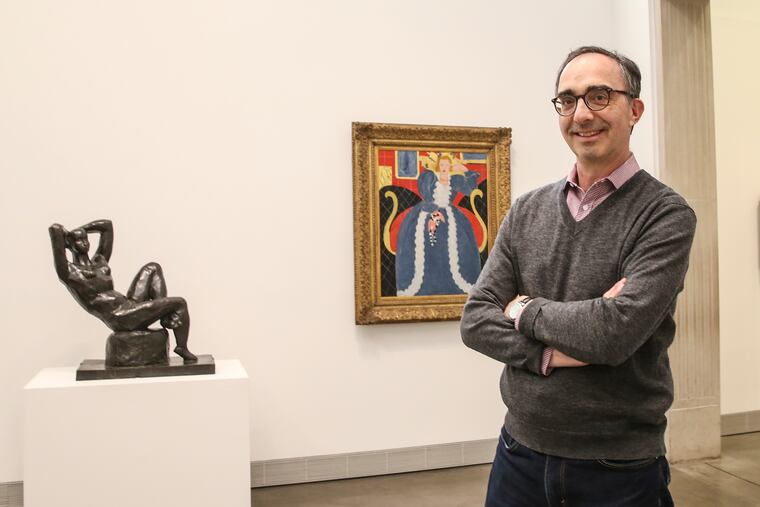New exhibition at Philadelphia Museum of Art: Philly rejuvenated Henri Matisse, French master
Matisse was feeling uninspired until he came to the US in the 1930 and Albert Barnes commissioned him to create a mural for the Barnes gallery in Merion. That changed everything.

In 1930, feeling a little old, a little lethargic, and a little dry, Henri Matisse, age 61, heeded the summons of Dr. Albert C. Barnes, the art impresario of Merion, founder of the eponymous foundation, and collector extraordinaire, to come to suburban Philadelphia.
Barnes wanted to talk a deal.
Matisse had moved to Nice from Paris in 1917 and had actually stopped painting for a year or so prior to coming to the United States. Was he just coasting?
Barnes would find out.
Create a mural, Barnes told him, for my Merion gallery.
It was an offer that apparently jump-started the next great phase of Matisse’s career.
After a Merion visit of only a few hours, Matisse eventually returned to Nice, and in 1933, the artist and the collector unveiled The Dance, a wall-mural triptych that dominates the Barnes Foundation gallery to this day.
Matisse’s U.S. visit, which included trips to Philadelphia, Baltimore, New York, and the 29th Carnegie International exhibition, plus a side trip to Tahiti, roused Matisse from the aesthetic doldrums, putting wind in his sail and ideas in his head.
The next decade of the 1930s saw a distinct change in his artwork, one that will be fully explored for the first time in a major exhibition opening at the Philadelphia Museum of Art, Oct. 19 for a run through Jan. 29.
Curated by Matthew Affron, curator of modern art at the PMA, Cécile Debray, president of the Musée National Picasso-Paris, and Claudine Grammont, director of the Musée Matisse Nice, the show will subsequently travel to the Musée de l’Orangerie in Paris, and the Musée Matisse in Nice.
Affron calls the 1930s a “transformative decade in Matisse’s career.”
The exhibition will walk visitors through the period immediately preceding his trip to Philadelphia, Affron said, a period when Matisse had moved to Nice and virtually stopped painting. In 1930, he came to the U.S., encountered Barnes, and agreed to the Merion commission that eventually yielded the next period of the artist’s work, one characterized by simplified forms and flatter works.
The Barnes commission also marked Matisse’s first major use of cutouts — a technique that dominated his work in later life.
“Matisse in the 1930s” will present more than 100 works, including well-known and rarely seen paintings and sculptures; drawings and prints; and illustrated books. The exhibition will also feature documentary photographs and films, and a scholarly catalog.
“Only through such an institutional partnership can we so vividly tell this story,” said Affron. “Between works on view at the Philadelphia Museum of Art and complementary holdings down the street at the Barnes Foundation, Philadelphia this fall will be an especially exciting city in which to experience Matisse’s extraordinary art.”
In other words, Philadelphia will become the epicenter for Matisse lovers this fall.
Grammont, of the Musée Matisse Nice, called the 1930s “rejuvenating” for the artist. Matisse “came back from the U.S. to France with a broadened vision of the world that had long-lasting effects,” said Grammont. That “broadened vision” produced a “fascinating modernist transformation,” said Debray, of the Musée National Picasso-Paris.
What exactly does this mean?
After his experience in Philadelphia and the U.S., Matisse returned to easel painting with new procedures and a new approach, the curators said.
He started using photography systematically to document the development of images and design, and to test his own reactions as he went along. He also began using pre-colored cut papers to plan his compositions; this procedure led him away from the illusion of modeling and deep space and toward a style of flat tones and bold shapes that gave his compositions of the 1930s a new impact, the curators said.
The exhibition is organized chronologically, with a prelude called “Interiors and Odalisques” that looks at Matisse’s Nice period, 1917–30. It closes with an epilogue centered on a 1941 surgery that led Matisse directly to a group of works of models in the studio and fruit and floral still lifes, “Themes and Variations.”
“Matisse spent most of his life in Nice, and Mediterranean splendor permeates his work,” said Grammont, but the trip to the U.S. shaped the work of his last years. “A new Matissian ‘map’ was drawn with the commission” of the Barnes mural, Grammont said. “It was consequently between Philadelphia and Nice that the main axis for these decisive years runs.”
The impact of that visit has never been examined in an exhibition before, said Affron.
Visitors, he said, will now have “a rare opportunity to immerse themselves in the very process through which Matisse generated a new creative approach and outlook in the later part of his career, while also witnessing the dramatically revitalized production that followed from his eventful visit to Philadelphia in 1930.”